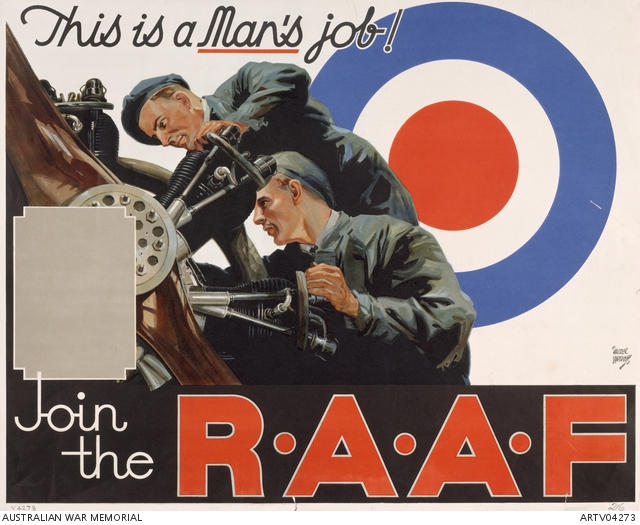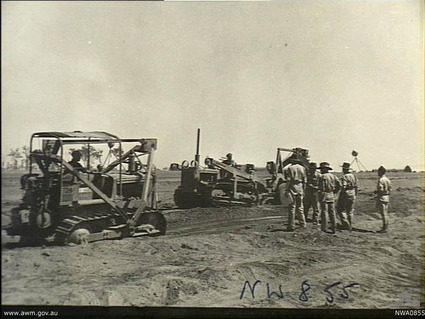Danes down under
Article
Eighteen Danes served in the Royal Australian Air Force during the Second World War. For most Danes in the Allied forces their service was connected—more or less directly—to the fight for the liberation of Danish. For those in Australian service, the stakes were different, and their service was perhaps more linked to the defence of their new country from the Japanese threat.
Australia is an nation of immigrants and it is, therefore, no surprise that where were Danish volunteers in the Australian forces during the Second World War, including the RAAF.
A search in the Australian Government’s Department of Veteran Affairs’ World War 2 Nominal Roll for veterans born in Denmark returns 251 individuals (203 in the Australian Army, 38 in the RAAF, 9 in the Royal Australian Navy and 1 in the Merchant Navy. Not all of these were Danes, but the numbers indicate the level of Danish participation ‘down under’.
Danes in Australia
Danish emigration to Australia in greater numbers commenced in the 1870s. The number of Danes in the country varied over the following decades. In 1933, 4,484 persons born in Denmark lived in Australia and 1,279 persons of Danish nationality lived in the country.[1] Fourteen years later, in 1947, the numbers had fallen to 2,758 persons born in Denmark and 482 persons of Danish nationality.[2] If one looks at the age distribution of the Danes in Australia, it is evident, however, that the potential for Danish recruitment in the country was not huge; in 1933, there was 308 Danish nationals by the age of 20-34 years living in the country, of which 262 were men. The number had fallen to 158 persons by 1947, of which 100 were men.
In comparison, it is estimated that 30,000 Danish-Americans were mobilized during the war.

Danes or Danish-Australians?
My initial work on this subject was carried out about fifteen years ago and published in the article Danish born servicemen in the Royal Australian Air Force on this site in 2010. My work then—as it has been since—was based on two primary sources. Firstly, the Australian Government’s Department of Veteran Affairs’ World War 2 Nominal Roll was used for the initial screening. Secondly, the excellent and very open access to individual service files at the National Archives of Australia has made it possible to research these individuals in detail to assess whether they can be considered Danish at enlistment or if the were already naturalised as Australians at that point.
The conclusions of the original research have not changed dramatically; of the total group of thirty-eight men and women in the RAAF, who were born in Denmark, only one person has been added to the list. This person is Henry Winter Rasmussen who is the son of a Danish national and volunteer and hereby, even if born in Australia, a Danish national according to Danish nationality law (jus sanguinis).
The single case of a Danish national born in Australia is also testament to the fact, that the number of Danish volunteers identified in my research is a conservative estimate of the Danish contingent of the Royal Australian Air Force. It it included children of not yet naturalised Danish immigrants born in Australia, the number of volunteers would be higher. These individuals would, as Henry Winter Rasmussen be British subjects as they were born in Australia (jus soli) and Danish nationals as they were born by Danish parents (jus sanguinis).
Some of the Danish born servicemen and women were naturalised in Australia shortly before or even after the outbreak of war. These include Cpl Terkel Trap Friis, who was naturalised in July 1940 (enlisted July 1942) and Warrant Officer Anders Krogh Jensen, who was naturalised in July 1939 (enlisted in August 1940). They are not included in the list of Danes, even if they may have considered themselves as such.
In supporting roles - in Australia
The Danish volunteers are in most cases perhaps best described as Danish-Australians. Ten had arrived in Australia before 1930, either as adult or as minors with their family. Several had married and established a family in this country. Only five arrived in 1940 or later signing off from merchant vessels arriving in Australia. Only a few of the volunteers returned to Denmark to live after the war.
The average age—circa 30 years—of the Danish volunteers in the Royal Australian Air Force was higher than that of Danes in other allied air forces. Of the eighteen men and women included, nine was over the age of 30 and five under the age of 20.
Most Danes served in supporting units and roles in the RAAF. Several of the volunteers served in one or more of the Mobile Works Units/Squadrons, in Works Maintenance Squadrons or in—as they were later renames—Airfield Construction Squadrons. Others were mustered as Motor Boat Crew serving as such in different types of units, including the Flying Boat Repair Units of Rathmines and Lake Boga. The excellent access to service records, personnel occurrence reports and unit records makes it possible to trace the non-commissioned ground crew in the RAAF in a manor that has not yet been possible in any other air force.
It is not the intention of this article to tell the story of each Danish volunteer in RAAF; the article gives an introductory note to the Danes as a group, whereas the individual biographies of each individual presents their story. A full list of the Danish nationals in the RAAF and another for the Danish nationals in the WAAAF are available. Not all individual biographies are complete at the time of writing, but they are completed as information and time allow.

Let me give a few examples. LAC Anton George Jensen was 42 years, when he enlisted in September 1942. Since arriving in Australia in 1927, he had worked 11 years as a farm hand end then he worked as a mine worker until enlistment. Jensen’s military service included almost a year in 1 Repair and Salvage Unit in the Northern Territory for almost a year. The RSUs were mobile units manned by all technical trades and carried out engine changes on forced landed aircraft, repaired damage, or boosted the manpower situation of squadrons where needed. After the end of the war in the Pacific, he served in Japan in 5 Airfield Construction Squadron as part of the British Commonwealth Occupation Forces.
Sgt Ernest George Bruhn was nearly fifty years old when he enlisted in the RAAF in 1942. He served at 1 Flying Boat Repair Depot in mid-1943, before being posted to the Darwin area in October 1943. He was involved in the construction of the flying boat base at Darwin and the repair and construction of several airfields in the area.

Cpl Hans Max Bruno Thomsen enlisted in October 1942 as motor boat crew. He attended No. 8 Motor Boat Crew Course at Marine School, RAAF Station Rathmines, New South Wales, which was the RAAF Maritime Section's main training base. The Motor Boat Crew were trained in navigation, seamanship, signals, boat handling, life saving, and technicalities of whether. Apart from supporting the flying boats the crews were also responsible servicing and maintaining their own vessels.
Thomsen served at 1 Flying Boat Repair Depot, RAAF Lake Boga, from early 1943, and was posted to 55 Operational Base Unit at RAAF Birdum and later 52 Operational Base Unit in Darwin. He was injured in an accident onboard the Sapphire—a RAAF Maritime Section General Purpose Launch—and never returned to active duty.

ACW1 Alice Rasmine Nielsen was one of two Danish WAAAFs. She enlisted in May 1943 at the age of 19. She was mustered as an office aid at enlistment and, later, she was re-mustered as clerk medical assistant. She was posted to 2 Medical Rehabilitation Unit at Clydesdale and Jervis Bay on 28 April 1945 and later she served as staff at 3 Personnel Depot.

Out of sight …
One of the reasons I have taken a particular interest in the Danish volunteers in Australia is that they not mentioned in the average Danish recollection of the Second World War. For obvious reasons, there is a tendency to focus on the European Theatre of War, which was more closely related to the liberation of Denmark, than was the defence of Australia og the South West og Pacific Theatres of War.
The servicemen and women in Australia served a very long way from home and in a country which covers a large territory. They volunteered and served as individuals and there was no coordination of the enlistment in Australia as it was the case to some extent in London.
The Danish representatives in Australia seems to have had little if any contact with Danes serving in the Australian forces. In November 1946, preparing the award of the King Christian Memorial Medal for participation in the War 1940-45, the Danish Ministry of Foreign Affairs asked Danish embassies all over the world were asked to provide a list of Danes who were eligible for the award, that is, Danish nationalt, who had volunteered for the allied military forces. In July 1947, the embassy in Canberra was able to forward three lists, including a list of Danish nationals, who had served in the RAAF, who had been provided to them by the Australian Department of External Affairs. The list included ten men, who are all among the volunteers compiled in my work. At the time, the embassy was not able to conclude if the men included in the list from the Australian authorities were eligible for the award, as they had no information on the nature of service, and therefore were not able to assess if the met the award criteria. Adding to difficulties, the Australian authorities informed the embassy, that the Danes, if eligible for both, had to chose between receiving the War Medal or the Danish Memorial Medal. It is clear from the case file that the Danish embassy had difficulties getting in touch with several of the Danish servicemen, and that some of them preferred to receive the War Medal in stead.[3]
According to the information available one one of the eighteen returned to Denmark for life after the war. Most of them had either found their new home country before the war, or chose the country as their new home after demobilisation. There is no doubt that this have also added to the lack of information about their service in Denmark.
Even so, their service has to be remembered. I have tried to do my part with my work over the years. And I shall continue.
Endnotes
[1] Australian Bureau of Statistics (2011). Census of the Commonwealth of Australia, 1933, Volume I - Part XI Nationality, p. 728-732 and 843-845. Of the 4,484 in Denmark born 3,348 were men and 1,136 women. Of the 1,279 Danish nationals 1,046 were men and 233 women.
[2] Australian Bureau of Statistics (2012). Census of the Commonwealth of Australia, 1947, p. 638-642 and 785-786. Of the 2,758 in Denmark born persons, 2,032 were men and 727 women. Of the 482 Danish nationals, 393 were men and 93 women.
[3] DNA: Udenrigsministeriets gruppeordnede sager, 1946-1972, 48.Y.90/Australien.